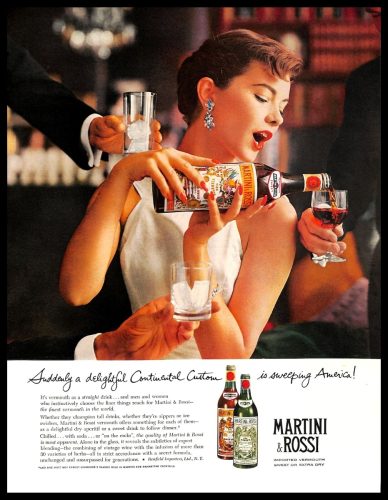One of the most dominant functions of the West Bend Penguin Hot and Cold Server was its use as an ice bucket, an important container for cocktail parties. A popular way to entertain, cocktail parties acted as gateways into glamorous evenings. After Prohibition, the graveness of the Great Depression, and the deprivation of World War II, Americans uncorked their craving for alcohol in the 1950s. Alcohol consumption nationwide rose from 190 million gallons in 1950 to 235 million gallons in 1960. During the day, mixed drinks were revered symbols of business savvy and all-American know-how, and the multi-martini lunch became synonymous with the deals that turned America into a postwar economic super-power. Advertisements of the period, which illustrated images of drinking as fashionable, gave alcohol consumption a veneer of sophistication and style.
But why the rise of cocktail parties, specifically in suburban homes? New suburban housing generally consisted of small or non-existent dining rooms; therefore, formal dinners were often replaced with informal cocktail parties where guests moved throughout the public areas of the house. Hosts no longer had to provide large meals. Instead, they offered a series of appetizers and mixed drinks. Cocktail parties, therefore, became a response to the limitations of the suburban house-plan. The Atomic Age home, nonetheless, was complete with the newest home appliances and filled with stylish and comfortable furniture, creating a convenient and aesthetically-pleasing environment in which to entertain.

Known today primarily for its use as an ice bucket and its relation to cocktail hour, the Penguin reflected and reinforced postwar changes in home entertainment, and it fulfilled the convenience demanded by busy modern families living in new suburban developments across the United States. Sought out by collectors and still used today, the server also serves as a testament to the quality and appeal of objects produced in West Bend, Wisconsin, in the twentieth century.
Written by Ann Glasscock, August 2014.
SOURCES
Karen Brooks, Gideon Bosker, and Reed Darmon. Atomic Cocktails: Mixed Drinks for Modern Times. San Francisco: Chronicle Books, 1998.
Timothy Miller, “The Path to the Table: Cooking in Postwar American Suburbs.” PhD diss., University of Kansas, 2012.
William H. Young and Nancy K. Young. The 1950s. Westport: Greenwood Press, 2004.






